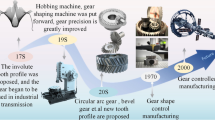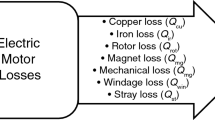Abstract
Minimization of frictional losses in the drivetrain of heavy-duty vehicles is important from both consumer satisfaction and environmental perspectives. Approaches to friction reduction in these components can be evaluated using simulation-based investigations. However, nearly all drivetrain components operate in the mixed lubrication regime which is difficult to model because both hydrodynamic lubrication and surface contact are significant and therefore, the total friction consists of hydrodynamic friction due to lubricant shearing and boundary film friction at asperity contact locations. Recent advances in simulation methods for mixed elastohydrodynamic lubrication (EHL) have enabled improved virtual design tools, such as those developed by Zhu and Hu and further improved by Liu et al. Here, these simulation tools are used to evaluate friction reduction and predict the effects on a mixed EHL interface under severe operating conditions. Three practical means of friction reduction are discussed based on the experimentally validated mixed lubrication friction model and its predictions made for representative, sample cases.










Similar content being viewed by others
References
Taylor, C.M.: Automobile engine Tribology—design considerations for efficiency and durability. Wear 221, 1–8 (1998)
Wakuda, M., Yamauchi, Y., Kanzaki, S., Yasuda, Y.: Effect of surface texturing on friction reduction between ceramic and steel materials under lubricated sliding contact. Wear 254, 356–363 (2003)
Ryk, G., Etsion, I.: Testing piston rings with partial laser texturing for friction reduction. Wear 261, 792–796 (2006)
Wakuda, M., Yamauchi, Y., Kanzaki, S., Yasuda, Y.: Effect of surface texturing on friction reduction between ceramic and steel materials under lubricated sliding contact. Wear 254, 356–363 (2003)
Mufti, R.A., Priest, M.: Experimental and theoretical study of instantaneous engine valve train friction. ASME J. Tribol. 125, 628–637 (2003)
Fox, I.E.: Numerical evaluation of the potential for fuel economy improvement due to boundary friction reduction within heavy-duty diesel engines. Tribol. Int. 38, 265–275 (2005)
Coy, R.C.: Practical applications of lubrication models in engines. Tribol. Int. 31, 563–571 (1998)
Bair, S., McCabe C., Cummings, P.T.: Calculation of viscous EHL traction for squalane using molecular simulation and rheometry. Tribol. Lett. 13, 251–254 (2002)
Xiao, L., Bjorklund, S., Rosen, B.G.: The influence of surface roughness and the contact pressure distribution on friction in rolling/sliding contacts. Tribol. Int. 40, 694–698 (2007)
Zhu, D., Cheng, H.S.: Effect of surface roughness on the point contact EHL. ASME J. Tribol. 110, 32–37 (1988)
Hu, Y.Z., Zhu, D.: Full numerical solution to the mixed lubrication in point contacts. J. Tribol., Trans. ASME 122, 1–9 (2000)
Zhu, D., Hu, Y.Z.: A computer program package for the prediction of EHL and mixed lubrication characteristics, friction, subsurface stresses and flash temperatures based on measured 3-D surface roughness. Tribol. Trans. 44, 383–390 (2001)
Zhu, D., Hu, Y.-Z.: Effects of rough surface topography and orientation on the characteristics of EHD and mixed lubrication in both circular and elliptical contacts. Tribol. Trans. 44, 391–398 (2001)
Liu, Y., Wang, Q., Hu, Y.Z., Wang, W., Zhu, D.: Effects of differential schemes and mesh density on EHL film thickness in point contacts. ASME J. Tribol. 128, 641–653 (2006)
Liu, S., Wang, Q.: Studying contact stress fields caused by surface tractions with a discrete convolution and fast fourier transform algorithm. J. Tribol. 124, 36–45 (2002)
Liu, S., Wang, Q., Liu, G.: A versatile method of discrete convolution and FFT (DC-FFT) for contact analyses. Wear 243, 101–111 (2000)
Zhu, D., Martini, A., Wang, W., Hu, Y.H., Lisowski, B., Wang, Q.: Simulation of sliding wear in mixed lubrication. ASME J. Tribol. 129, 544–552 (2007)
Cizaire, L., Vacher, B., Le Mogne, T., Martin, J.M., Rappoport, L., Margolin, A., Tenne, R.: Mechanisms of ultra-low friction by hollow inorganic fullerene-like MoS2 nanoparticles. Surf. Coat. Technol. 160, 282–287 (2002)
Grossiord, C., Varlota K., Martin, J.-M., Le Mogne, T., Esnouf, C., Inoue, K.: MoS2 single sheet lubrication by molybdenum dithiocarbamate. Tribol. Int. 31, 737–743 (1998)
Unnikrishnan, R., Jain, M.C., Harinarayan, A.K., Mehta, A.K.: Additive–additive interaction: an XPS study of the effect of ZDDP on the AW/EP characteristics of molybdenum based additives. Wear 252, 240–249 (2002)
Morina, A., Neville, A., Priest, M., Green, J.H.: ZDDP and MoDTC interactions and their effect on tribological performance—tribofilm characteristics and its evolution. Tribol. Lett. 24, 243–256 (2006)
Author information
Authors and Affiliations
Corresponding author
Rights and permissions
About this article
Cite this article
Martini, A., Zhu, D. & Wang, Q. Friction Reduction in Mixed Lubrication. Tribol Lett 28, 139–147 (2007). https://doi.org/10.1007/s11249-007-9258-1
Received:
Accepted:
Published:
Issue Date:
DOI: https://doi.org/10.1007/s11249-007-9258-1




